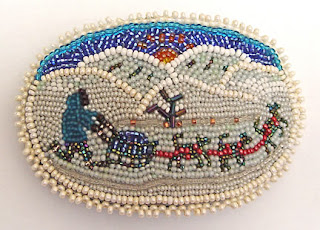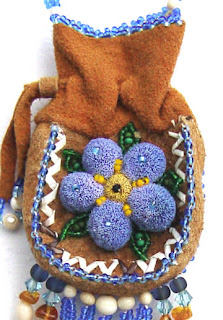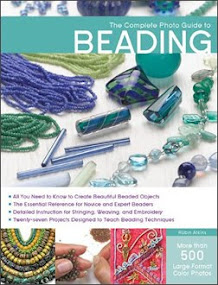
I love almost all Native American beadwork. It was what drew me toward beads in the first place. I've been thinking about why I like it so much. Perhaps it's because it offers honest simplicity, down-to-earth practicality, and intent stemming from the heart rather than the intellect. Maybe it's the colors and the repetitiveness of design. The excellence of craftsmanship is part of it too. When I touch a bag, belt, moccasins, doll or other significant item made by a Native American, it seems to voice the essence of the artist, emitting a feeling of energy and life.
Emphasizing different colors, motifs and techniques, each tribe has its own recognized style. The barrette above and the ones following were made by Northern Alaskan Natives, beaded on hide. They are part of a collection owned by Kathy Hinkle, whose beadwork dolls and improvisational bead embroidery were featured in my previous post here.



An often overlooked, but fantastic place to see and buy Native Alaskan beadwork (and baskets) is at the Alaska Native Medical Center in Anchorage. The current facility, built in the late 1990's, replaces a much older hospital. The gift shop offers very high quality Native arts and crafts. The auxilliary volunteers who ran the shop in the old (and now in the new) facility purchased the best work that came through the shop, establishing a hospital collection, which is displayed in large, beautifully designed cases on each floor of the hospital and in small cases along the grand spiral staircases between the levels. In my opinion, the work in these cases, equals or exceeds any I've seen in a museum; and the work in the gift shop is better than most Anchorage or Sitka galleries or shops offer.
Here is something I bought at this wonderful gift shop.

Made by Thelma Claffey of Huslia AK, this amulet bag of moosehide features caribou tufting, quill work and beads of ivory and amber. It's one of my most prised treasures!

Since I'm on a roll, here are a few sketches from my note book, and a little information about places to see Native American beadwork on the East Coast.

Above is a sketch of the head of a Northern Plains Indian doll from around 1900 seen at the Bruce Museum in Greenwich CT. She has a leather face, bits of leather couched on for ears, a triangle of leather folded and sewn into the shaping seam for her nose. Her cheeks and mouth are painted, but her eyes are glass seed beads.

This is a sketch of another doll I saw and loved, but couldn't afford to buy in the gift shop of the National Museum of the American Indian in New York City. Although she was modern, she had an old-world look and feel. The designs were painted on coarse cloth, and then accented with the traditional colors of opaque and white-heart seed beads. The seams of the doll were embellished with a stitch I'd never seen before and haven't seen since. Made with very tiny seed beads (perhaps size 16), it was dense, like a wrapped seam, but appeared to be woven in a cross-hatch pattern. I spent a whole day in this museum, and wished I had time to return the next day. The exhibitions were supurb.

Here is one other sketch I made while there. It's a Lakota turtle amulet, approximately 7 inches long by 6 inches wide, all done in lazy stitch on hide.
I totally admire artists who keep sketch books, many of which are works of art in themselves. Cynthia Toops is a polymer clay artist, who is always sketching her ideas in little hand-bound books, later to be realized as miniature masterpieces. Inspired by Cynthia, I made a book and vowed to sketch every time something pleased me or caught my eye. That was in April of 1998, and there are still many blank pages in the book. The filled pages infuse my heart with joy and inspiration. What happened? Why haven't I kept it up? This doesn't make sense at all. Do I need to make a blogmittment?
By the way, here is a fun book about art journaling and sketching by Lynne Perrella.
















what kind of needles do they use for beading on leather? I know there are special needles, but I can't imagine a needle that would be strong enough to go through leather AND small enough to go through a seed bead!
ReplyDeleteare the things you've shown pins? barrettes?
Oh Robin, thank you so much for this great window into another world of beading!
ReplyDeleteI esp. loved the sled dog barrette...so much was conveyed, and so simply.
It reminded me of a Navajo rug I saw once...done in that superbly crafted tradition, it depicted pick-up trucks in front of little square houses on a desert background. The juxtaposition of the weaving and the subject went straight through my heart!
No fair, Robin ---- LOL ---- I haven't even begun to scratch the surface of where I am and now, with these lovely examples, you have me wanting to run hither and yon searching out even more wonderful beading experiences.
ReplyDeleteSeriously, thank you -- loved these entries. And I have enough eye candy to satisfy me for days.
To Soren ~ The top 4 images are of barrettes. Yes, there are special leather sewing needles, which in cross section are triangular. Some leather needles are made that are small enough to pass through size 10 seed beads, or even 11s if the holes are large enough. Some hides are tanned in a way that makes them soft enough for a regular beading needle. Some hides are so think that beaded embellishments are sewn into the surface only (not all the way through the hide). Hope this helps.
ReplyDeleteAs a child I was fascinated with Native American beadwork. I always loved the color and design they applied to their clothes and jewelry. I don't own any but I still admire it. Thank you for showing such beautiful examples here. The amulet bag is my favorite. The sketches area good idea. The second one made me do a double take as the one and only spirit doll I made has that same shape and a spiral on the front.
ReplyDeleteI almost bought that Lynne Perrella book the other day! Maybe I'll go back and get it now.
I do really like your blog, Robin.
ReplyDeleteIt is very personal, and I enjoy every single word I read here. Thank you very much.
I too like the sketching books that many artists maintain. I think they are sometimes better than their finished pieces.
ReplyDeleteWhile I'm not a big fan of Native American beadwork on the whole, I do love the button blankets of west coast Indians and the lovely floral patterns from the east coastal groups. However, I think your bag is really super because it has so many Alaskan Elements to it. I also like the design.
Love these examples. thanks so much for sharing.
ReplyDeleteI love to look at Native American beadwork, too. And, I especially love the first barrette you posted. That is quite detailed work=:)
ReplyDeleteYour work isa wonderfull!!! so many ideas , so many colors. It's a great work I'll come back again.
ReplyDeleteThe amulet bag was not made by Thelma Claffey because I'm from Huslia and I don't know who that is. I do know who made it though.
ReplyDeleteTo Sunwatcher ~ Thanks for your comment. I still have the tag that came on the bag. I keep it inside the bag. The tag says the artist is Thelma. Do you think the gift shop mixed up the tags somehow? Who do you think made it? Whoever made it, I certainly would like to see more of her beautiful work. Robin
ReplyDeleteTo Suncatcher ~ Sorry about my mistake about your name (above comment). I should have proofed my comment before publishing.
ReplyDeleteHello, my mom said there is a Thelma Claffey from Huslia but the amulet bag looks like Selina Alexander's beadwork. She does beautiful beadwork and she has a lot of her beadwork in gift shops.
ReplyDeleteThanks so much for writing back, Suncatcher. And thanks for checking with your mom. I'll keep a look out for Selina's beadwork the next time I'm in Anchorage. Blessings!
ReplyDeleteHello- I love beadwork and have done quite a bit, mostly lazy stitch. The leather used might be brain tanned, with is very soft like chamois and done by hand. Can even blow air through it. Sewing beads on it is quite easy. It is not like garment or other commercial tanned leather. Beading needles can be found at sewing and hobby craft stores. Beads can be bought loose or in hanks. There are special strong threads made for beading.
ReplyDeleteIt's great to see that people still appriciate my mothers work (Thelma Claffey, maden name Dewild). She hasn't done anything new since about 1998 and it makes me happy to see pictures of her stuff online.
ReplyDeleteSalina and Thelma are sisters.
ReplyDelete